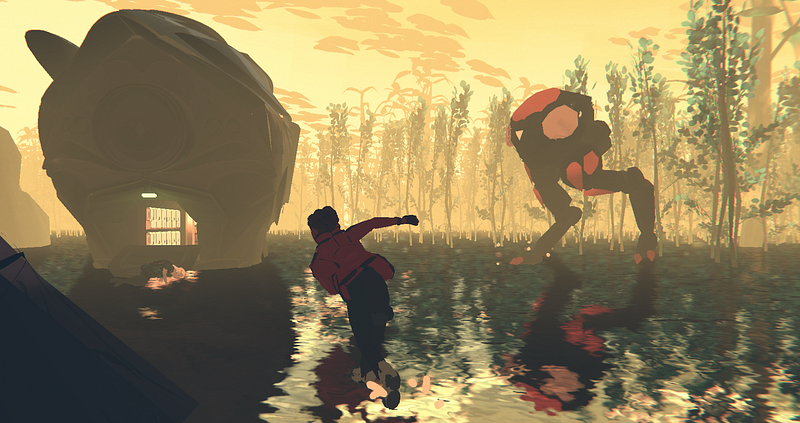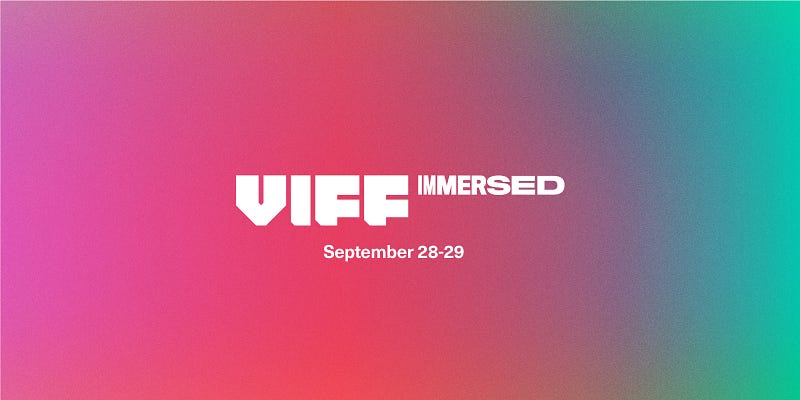 Dami & Falian: How Was Your Day — Finalist
VIFF Immersed 2019 Animation Category
Dami & Falian: How Was Your Day — Finalist
VIFF Immersed 2019 Animation Categoryby Brian Seth Hurst and Caitlin Burns
In December of 2014, Samsung introduced the Gear VR Innovator Edition. It was the culmination of years of hope and hype the signaled the birth of a new medium. This would change the language of filmmaking: the way stories were told and the ways audiences experienced those stories forever. At least, that was the promise.
As veterans of the “new media” side of the entertainment industry, we are also veterans of the hype cycle that goes with the introduction of emerging technology — from interactive television, to webvideo, to “mobisodes,” “transmedia,” and 3D TV. Some hits. Some misses. Some millionaires. Some bankruptcies. Innovation marches on.
“Some hits. Some misses. Some millionaires. Some bankruptcies. Innovation marches on.”
There is a value chain from idea to reality in entertainment innovation. First comes investment in the technology. Then the technology — in the case of virtual reality, the head-mounted display (HMD), the compute power, the cameras… then the content creators… and then, hopefully, the audience.
That link to the audience is reminiscent of what they used to call “the last mile” in fiber-optic technology — a serious challenge. If you’ve been in the business of new media long enough, you know how hard it is to explain why a groundbreaking new experience is going to change the way people see the world. It’s even harder to get audiences to agree with you that seeing the world in this new way is something they’d want. Explaining an immersive piece verbally is about as effective as dancing about architecture. Now do that for the entire global audience.
 Everest VR Film Experience— Finalist VIFF Immersed 2019
Documentary Category
Everest VR Film Experience— Finalist VIFF Immersed 2019
Documentary CategoryOnly now, after 5 years, is the dearth of great VR content beginning to change, moving from novelty to filmmaking. But since those early days the category has expanded and virtual reality has become a subset of what has come to be called the “immersive industry” and comes under the banner “XR,” which includes mixed reality (MR), augmented reality (AR), immersive domes and so much more.
Unlike 5 years ago, there is a distribution ecosystem, including in-home, out-of-home (location-based entertainment), and head-mounted displays in MR, such as those iterations from Oculus, HTC, Samsung, Playstation VR, Microsoft, and Magic Leap mobile AR. There are even independent distribution platforms such as Littlstar and VeerVR. Those distributors can connect a piece to a pre-existing global audience.
Sure, enterprise applications for training, real estate, and spatial computing continue to develop in medicine, architecture, education, travel, and customer service. Production companies have found that enterprise work can keep them afloat. It’s not as glamorous, but the experience still allows for innovation in storytelling.
There remain two great challenges to creators of immersive entertainment: funding and consumer pick-up
First, Funding.
When the reality of Virtual Reality hit, what little funding there was, seemed to dry up. At the same time, the production companies and professionals that didn’t plan ahead for the long game disappeared. Many in the industry declared 2018 the year of the “trough of disillusionment.” It’s easy to believe. Unlike new media revolutions of the last 10 years, immersive entertainment is not making an art more accessible, cheaper to create, easier to access, or reducing the skill level required to make it well. Quite the opposite. These fields require collaboration, are intense productions, are still developing, and require significant time and budgets to bring to life.
Luckily for everyone, plenty of creative teams are pushing through the trough, and innovation continues. Distribution platforms are more dedicated to VR gaming, but the content library for cinematic VR, animation, and documentary continues to grow. Creators can still find government technology and content funding in countries such as Canada, France, the UK, and China. As a matter of fact, XR is a major area in the Chinese Government’s master plan.The national and local governments support immersive technology, content and distribution. Work is now being created that is at the same level of quality as major film and television releases, from teams all over the world, even as they are developing their own fundraising and business models and working with brands to finance their growth.
It’s as hard to make immersive content now as it was for independent filmmakers in the early 1990s, and for independent game companies in the early 2000s. But many creators are not scared off by a challenge.
 [5x1]
The Making Of — Finalist VIFF Immersed 2019 Cinematic Category
[5x1]
The Making Of — Finalist VIFF Immersed 2019 Cinematic CategoryBut where are the audiences?
We still haven’t made it to the mass adoption era of the technology curve. It’s a slow build that is now, like any premium service, requiring consumer investment of money and time, dependent on the quality of the content, including games, narrative and interactive narrative, and a continued flow of that content.
XR technologies have relied on the “If you build it, they will come” mentality when it comes to developing creator teams, content, and audiences. The platforms (Facebook’s Oculus, Google, and HTC) actually founded their own content studios, making significant investments in award-winning content. But Oculus Story Studios and Google Spotlight Stories have closed, and whole internal divisions have been re-focused on younger, hotter, newer media trends.
The role of film festivals
Film festivals recognized a few years ago that they needed to highlight and be part of the immersive revolution. Curators brought unique content experiences to festival-goers. Much of the content was based on installations, one-of-a-kind experiences that could only be seen and experienced by attendees. While some of that content found distribution on a handful of services, the majority of the content was not available for audiences beyond the festival.
Part of the goal of showcasing at a film festival is to get a distribution deal.
Traditionally, film festivals present creators with the opportunity for distribution. Part of the goal of showcasing at a film festival is to get a distribution deal.
While the industry is still working to establish solid business models and ROI on the content side, it cannot do so without quality content. At this time, the quality is better than it has ever been allowing such content to take its place alongside traditional forms such as television and film as a viable and transformative storytelling medium.
We’ve both advised and consulted for major companies and institutions, but when we connected with the Vancouver International Film Festival (VIFF) we finally found a team that wanted to bring some of the strongest commercial tools for content available for film and tv creators to the immersive landscape.
The executive team at the festival — led by experts who had helped catalyze Alberta’s film and television industry as well as the incredible Production-Gaming-Animation-VFX mecca that Vancouver has become, heard our concerns and wanted to ensure that there is a place for work aimed at commercial distribution to truly thrive.
In 2017, Jacqueline Dupuis, the executive director of the Vancouver International Film Festival approached StoryTech® Immersive (S/I) to assist in the production of a virtual reality conference track and a limited exhibition of content. We agreed, and “VIFF VR” was born. As producers of immersive content, both cinematic and live, we saw in that first year an opportunity as producers to build a conference of relevant case studies for content creators. According to the VRARA, Vancouver is the number two XR ecosystem in the world. What was a relatively small initiative resonated with festival attendees and the Vancouver VR community.

The birth of VIFF Immersed
In 2018, as the industry had some growing pains, we all agreed it was time for some serious conversation and collaboration. We decided to build a solid strategic foundation for extending the Vancouver International Film Festival brand into the world of XR and VIFF Immersed was launched. It needed to be a different sort of festival for content creators — we wanted them to have not just the opportunity for exhibition but for commercial distribution to the world.
The opportunity: to connect phenomenal narrative work with the available at-home audiences.
Our focus was on work that could be delivered to audiences both at home and in location-based entertainment environments. We decided that VIFF Immersed would focus on content that was already in — or would be available for — commercial distribution to mass audiences. It was also decided to develop VIFF Immersed as an international market initiative to support development, production, and distribution.
VIFF Immersed 2019
Now in its second year, VIFF Immersed continues to extend the Vancouver International Film Festival’s mission of “celebrating excellence in screen-based storytelling” with a robust program initiative, which includes:
- New Realities in Storytelling: a high-level conference day focused on creators’ work and insights from distributors about what they’re actually looking to connect with audiences.
- International VIFF Immersed Competition: a contest that requires story-driven submissions be already in or available for commercial distribution. More than 90 eligible submissions from 30 countries were received in the categories of cinematic VR, documentary, and animation. Those entrants selected as finalists evidence the evolution of XR content allowing the work to be judged by the same standards applied to traditional film in terms of story and production.
- VIFF Immersed Public Exhibition: a showcase of story-driven virtual reality productions in live action, animation, and documentary. In addition to showcasing the finalists in competition, there is a curated selection of stand-out British Columbian content: the “BC Showcase” sponsored by Creative BC, and freestanding installations at festival locations showcasing the work of independent Canadian creators presented by the Canadian Council.
- BC Immersed: a day of hands-on workshops in all aspects of immersive production for filmmakers and their teams. This day is also aimed at connecting local creators with international teams to network, learn, and find new collaborators.
- The BC Tech Crawl: developed for buyers, distributors, and producers from other countries to tour and present Vancouver-based immersive tech and production companies offering the opportunities for co-production, content distribution, and work for hire in both entertainment and enterprise. The program resonated even more deeply with the creative community, especially the workshops.
- VIFF Immersed Co-Production Market: a collaboration with the Kaleidoscope Fund to connect projects in development with investment, grants and co-production opportunities.
- A major marketplace initiative focusing on the state of the industry in Vancouver, BC, Canada and centers of production and distribution globally will be developed and published later in the year.
One of the defining features of VIFF Immersed is the intention to bring the innovative XR narrative work in cinematic VR, documentary and animation to audiences — not just in Canada — but globally. With this in mind, VIFF Immersed has established featured channels with at-home distributors VIVEPORT and VeeR VR for the duration of VIFF 2019 (September 28 — October 13). The extension of the VIFF Immersed Exhibition onto these platforms gives creators an opportunity to showcase their work to not just audiences around the world but to investors, producers, and distributors.
This year we’ll also be presenting The VIFF Immersed VeeR VR Global Audience Award, voted on by viewers outside of North America.
 Unceded Territories —
Official Curated Selection, VIFF Immersed Exhibition 2019
Unceded Territories —
Official Curated Selection, VIFF Immersed Exhibition 2019Film festivals have always provided a place for new voices to be heard, new stories to be told, and new ways of telling those stories. With a history of more than 30 years celebrating “excellence in screen-based storytelling,” VIFF has been a showcase and a platform for connecting storytellers to audiences as well as a gateway for creators to the business of storytelling and distribution. It was natural for the festival to extend both its brand and mission to support the screen-based narratives being created in immersive media and to support the establishment and continued building of a commercial immersive marketplace.
In a very short time, VIFF Immersed has become an essential event for XR storytellers, distributors, and investors and, of course, an audience longing to experience exceptional storytelling.
Learn more about VIFF Immersed 2019 here
VIFF Immersed 2019 runs from Sept. 28 — Oct. 2, 2019 At Pyatt Hall & The Annex in Downtown, Vancouver, British Columbia, CA
________________________________
Brian Seth Hurst is Chief Storyteller and President, and Caitlin Burns, is Executive Producer, at StoryTech® Immersive. The company, based in Los Angeles, combines master storytelling and deep technological expertise to deliver unequaled best-in-class Cinematic Virtual Reality, Live 360 Broadcasting and advanced Augmented Reality Applications.
Immerse is an initiative of the MIT Open DocLab and The Fledgling Fund, and it receives funding from Just Films | Ford Foundation and the MacArthur Foundation. IFP is our fiscal sponsor. Learn more here. We are committed to exploring and showcasing media projects that push the boundaries of media and tackle issues of social justice — and rely on friends like you to sustain ourselves and grow. Join us by making a gift today.